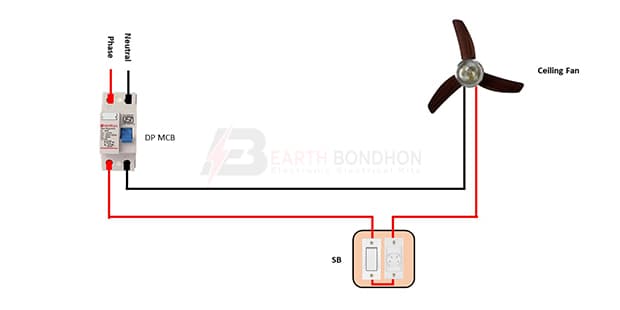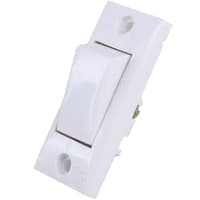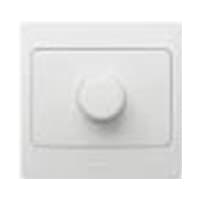Regulator Connection With Ceiling Fan:
This diagram shows how to make a regulator connection with a ceiling fan. In this circuit diagram, we use a DP MCB ( Double Pole Miniature Circuit Breaker ) a ceiling fan, a switch, and a fan regulator. First, we need to input phase and neutral to DP MCB. Then From DP MCB input neutral to the fan and input phase line to the switch and regulator. Then from the regulator connect the phase line to the ceiling fan. If you have not clear yet, please check our youtube video below the post.
Advertisements
Components needed For this Project:
You can get the components from any of the sites below:
- DP MCB 10A [See Buy Click Amazon]
- Ceiling Fan 56-Inch [See Buy Click Amazon]
- SPST Switch [See Buy Click Amazon]
- Fan Regulator [See Buy Click Amazon]
*Please note: These are affiliate links. I may make a commission if you buy the components through these links. I would appreciate your support in this way!
Advertisements
Components used to make the Regulator Connection With Ceiling Fan:
DP MCB In 2 Pole MCB, switching & protection is affected in phases and the neutral. A Double Pole or DP Switch is a Switch that Controls 2 Circuits at the same time. In terms of Residential Switching, this Normally means it Switches the live and Neutral at the same time. In Layperson Terms, Double Pole switches or DP Switches are Exclusively Designed to Control 2 Different Electrical Circuits at the same time, which allows the Appliances to Isolate safely and reliably. Fan or light Combinations and Medical Equipment are some of the many applications for DP Electrical Switches and Electrical components.
02. Ceiling Fan:
A Ceiling Fan is a fan Mounted on the Ceiling of a Room or space, Usually, Electrically Powered, That Uses hub-mounted Rotating Blades to Circulate air flow. They cool people effectively by increasing speed. It Doesn not Cool the Air Temperature — we Feel Cooler Because the Fan Moves the Air Around Us, a Process Called Evaporative Cooling. Evaporative Cooling Works like this: A cold day will feel Even Cooler if There is a Breeze Because of the wind Chill Factor.
An SPST (Single Pole Single Throw) Switch is a Switch That only Has a Single Input and can Connect Only to one Output. This means it Only Has one Input Terminal and Only 1 Output Terminal. A Switch is a Mechanical or Controlling Device That Changes the Flow of Current Direction or Interrupts the Flow of Current Within a Circuit diagram. An electrical line using Single Pole Single Throws (SPST) is Perfect for on-off switching. When the SPST is closed, the Circuit is Closed and the light from the lamp switches on the system. When The Single Pole Single Throw (SPST) is then opened, the light from the lamp goes out and the Circuit is off.
04. Fan Regulator:
A Fan Speed Controller Controls The Voltage Across the Fan and Therefore Indirectly Controls its speed 220v AC line. A ceiling Fan Speed Regulator Actually Measures and Regulates the Speed of the Fan Using its Tachometer. Fan Speed is Controlled with Thyristor or Transformer Speed Controllers for Ceiling fans, and table fans. the fan is Controlled by a Capacitor, and the Voltage across the fan Determines the fan speed. A Speed Control loop Can be Implemented That is Independent of Manufacturing Variances and Wear on The Fan control system.
Thank You for visiting the website. Keep visiting for more Updates.
Frequently asked questions
A series connection implies the power supply resistance is in line with the fan. This reduces the voltage drop across the Circuit Diagram fan and its speed to your desired level. The greater the resistance, the higher the voltage drop across it, and that lowers the speed of the fan.
Using a fan without a regulator can potentially Power supply lead to damage if the fan is designed to be used with a regulator. Without a regulator, the fan may operate at a constant speed, which could cause the motor to overheat and potentially lead to damage over time.
Currently, Fan Regulators are of these 4 types: Resistive regulator Phase angle controlled, and regulator Inductive regulator are Capacitive regulators (latest). This is the most common type of household ceiling fan. It works by providing different taps on a wire and wound resistor connected in series with the fan.
A fan regulator increases the speed of a fan by controlling the amount of electrical power supply supplied to the fan motor. This is typically achieved using a variable resistor or electronic circuit Diagram to adjust the voltage or current flowing to the motor.
Lastly, but most importantly is the speed regulator. Most of the time, the ceiling fan is in perfect shape but the regulator, a small round knob placed on the wall switch powering the fan, is broken. As suggested, the speed regulator and determines the speed at which the fan rotates.
Read more Single Phase Wiring
What is a kilowatt-hour (kWh) | kwh formula | What does kwh mean
Introduction to Electrical Units and CircuitskW and kWh on your electricity bill As your home uses electricity during...
What is the Difference Between kVA | What does KVA mean | kVA formula
Difference Between KVA ExplainedWhat does KVA Mean? There are technical terms aplenty when it comes to generators, and...
Power Factor | Power Unit | Energy | Electricity Unit
Power factor definition | Calculating Power FactorPower Factor Values In a purely resistive circuit, the power factor...





0 Comments